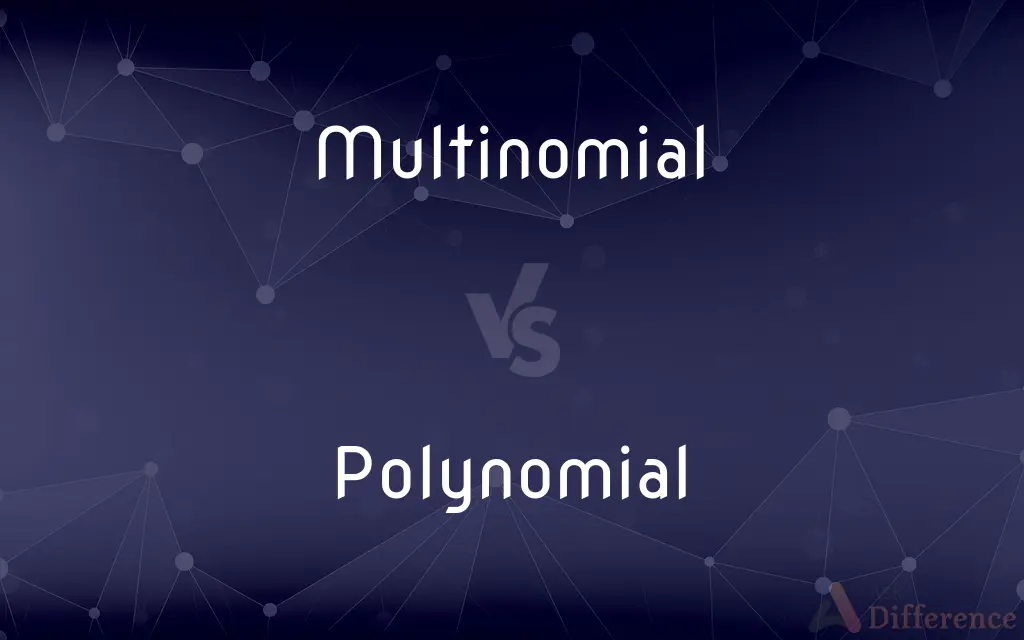Multinomial vs. Polynomial — What's the Difference?
By Maham Liaqat & Fiza Rafique — Updated on April 3, 2024
A polynomial is an expression consisting of variables and coefficients, using operations like addition, subtraction, and multiplication. Multinomial, a type of polynomial, specifically refers to an expression with more than two terms.

Difference Between Multinomial and Polynomial
Table of Contents
ADVERTISEMENT
Key Differences
A polynomial is a mathematical expression involving a sum of powers in one or more variables multiplied by coefficients. These expressions are fundamental in algebra and can range from simple (linear and quadratic equations) to more complex forms involving higher degrees. On the other hand, a multinomial extends the concept of a polynomial by being a specific type of polynomial that has more than two terms. This distinction highlights the complexity and variety within polynomial expressions.
Polynomials are classified based on the number of terms they contain: monomials (one term), binomials (two terms), and trinomials (three terms), with multinomials (more than two terms) encompassing the latter two and any other expression with more terms. Thus, while every multinomial is a polynomial, not every polynomial is a multinomial, as the category excludes monomials.
The degree of a polynomial, which is the highest power of the variable in the expression, plays a crucial role in determining its behavior and properties. Multinomials, as a subset of polynomials, also follow this characterization, but they inherently possess a broader scope for interaction between their terms due to their multiple-term nature, affecting their graphical representation and the complexity of solving them.
In practical applications, polynomials are used in a wide range of fields, including physics, engineering, and economics, to model relationships and predict trends. Multinomials, by virtue of being polynomials with more complexity, are particularly useful in statistics (e.g., multinomial distributions), combinatorics, and in situations requiring the modeling of events with more than two outcomes.
While solving a polynomial equation, the focus is on finding the roots of the equation, which are the values of the variable that satisfy the equation. The process of solving multinomials involves similar techniques but can be more intricate due to the increased number of terms, which can influence the equation's factorability and the methods suitable for finding its roots.
ADVERTISEMENT
Comparison Chart
Definition
An expression of variables and coefficients involving operations like addition and multiplication.
A polynomial with more than two terms.
Types/Classification
Monomials, binomials, trinomials, multinomials.
A subtype of polynomials.
Degree
Determined by the highest power of the variable.
Also determined by the highest power, but specifically applies to expressions with multiple terms.
Applications
Broad use in various fields for modeling and analysis.
Especially useful in statistics, combinatorics, and complex modeling.
Solving Techniques
Root finding, factoring, algebraic manipulation.
Similar techniques, but complexity can increase with more terms.
Compare with Definitions
Multinomial
An algebraic expression with a combination of numbers and variables.
3x +2x−5 is a quadratic polynomial.
Polynomial
Used in complex modeling and statistical distributions.
The probability distribution of rolling a dice can be represented by a multinomial.
Multinomial
Can have one or more terms, but operations are limited to addition, subtraction, and multiplication.
5x−3 is a linear polynomial.
Polynomial
Multinomials require careful factorization and solving techniques.
Solving x2 +x+1=0 involves quadratic formula application.
Multinomial
Used to model real-world situations.
The area of a square can be represented as x2, where x is the length of a side.
Polynomial
A polynomial with more than two terms.
X2 +3x+4y−7 is a multinomial.
Multinomial
The degree is the highest exponent of the variable.
In 4x4 +2x3 −x+9, the degree is 4.
Polynomial
More terms mean more interactions between variables.
In x3 +2xy+y2, xy represents an interaction term.
Multinomial
Consists of terms that are only added, subtracted, or multiplied.
X −4x+7 is a cubic polynomial.
Polynomial
Can be expanded using the multinomial theorem.
(a+b+c)2 is an example of multinomial expansion.
Multinomial
See polynomial.
Polynomial
In mathematics, a polynomial is an expression consisting of variables (also called indeterminates) and coefficients, that involves only the operations of addition, subtraction, multiplication, and non-negative integer exponentiation of variables. An example of a polynomial of a single indeterminate x is x2 − 4x + 7.
Multinomial
(mathematics) polynomial
Polynomial
Of, relating to, or consisting of more than two names or terms.
Multinomial
(mathematics) polynomial
Polynomial
A taxonomic designation consisting of more than two terms.
Multinomial
Same as Polynomial.
Polynomial
An algebraic expression consisting of one or more summed terms, each term consisting of a constant multiplier and one or more variables raised to nonnegative integral powers. For example, x2 - 5x + 6 and 2p3q + y are polynomials. Also called multinomial.
Multinomial
A mathematical expression that is the sum of a number of terms
Polynomial
An expression of two or more terms.
Multinomial
Having the character of a polynomial;
A polynomial expression
Polynomial
An expression consisting of a sum of a finite number of terms, each term being the product of a constant coefficient and one or more variables raised to a non-negative integer power, such as . Category:en:Polynomials
Polynomial
(taxonomy) A taxonomic designation (such as of a subspecies) consisting of more than two terms.
Polynomial
(algebra) Able to be described or limited by a polynomial.
Polynomial
(taxonomy) of a polynomial name or entity
Polynomial
An expression composed of two or more terms, connected by the signs plus or minus; as, a2 - 2ab + b2.
Polynomial
Containing many names or terms; multinominal; as, the polynomial theorem.
Polynomial
Consisting of two or more words; having names consisting of two or more words; as, a polynomial name; polynomial nomenclature.
Polynomial
A mathematical expression that is the sum of a number of terms
Polynomial
Having the character of a polynomial;
A polynomial expression
Common Curiosities
What is a polynomial?
A polynomial is an algebraic expression consisting of variables and coefficients, structured through addition, subtraction, and multiplication.
What makes a polynomial a multinomial?
A polynomial becomes a multinomial when it contains more than two terms.
What is the significance of the degree in a polynomial?
The degree of a polynomial, the highest power of its variable(s), determines the polynomial's properties and the shape of its graph.
Why are multinomials important in combinatorics?
Multinomials facilitate counting in complex scenarios involving partitions or grouped outcomes.
How do you classify polynomials?
Polynomials are classified based on their number of terms (monomial, binomial, trinomial) and their degree.
Can multinomials have any number of variables?
Yes, multinomials can have multiple variables, adding to their complexity and application in various mathematical fields.
Can a polynomial have no variables?
Technically, yes. A polynomial can be a constant term, considered a polynomial of degree zero.
Are all multinomials polynomials?
Yes, all multinomials are polynomials, but not all polynomials are multinomials.
How does the number of terms in a polynomial affect its solving?
More terms often mean more complexity in solving, affecting factorization, root finding, and graphical analysis.
What's the difference in graphing a polynomial vs. a multinomial?
Graphing a multinomial, as a type of polynomial, involves the same principles but might show more complexity due to additional terms.
What challenges arise when solving multinomials?
Solving multinomials can be complex due to their multiple terms, requiring intricate factorization and algebraic techniques.
How are polynomials used in real life?
Polynomials model physical phenomena, economic trends, and are used in engineering calculations, among other applications.
What role do multinomials play in statistics?
In statistics, multinomials model the probabilities of outcomes for events with more than two possible results.
How is the multinomial theorem used?
The multinomial theorem expands powers of sums involving more than two terms, aiding in algebraic simplifications and calculations.
Share Your Discovery

Previous Comparison
Cowpox vs. Smallpox
Next Comparison
Beige vs. SandAuthor Spotlight
Written by
Maham LiaqatCo-written by
Fiza RafiqueFiza Rafique is a skilled content writer at AskDifference.com, where she meticulously refines and enhances written pieces. Drawing from her vast editorial expertise, Fiza ensures clarity, accuracy, and precision in every article. Passionate about language, she continually seeks to elevate the quality of content for readers worldwide.














































